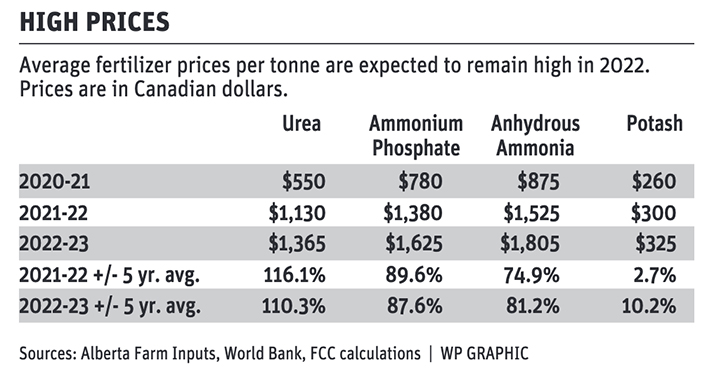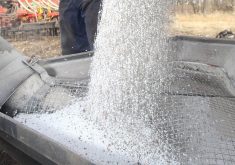North America’s red-hot fertilizer market is beginning to show signs of cooling — a welcome development for Canadian growers who still haven’t closed a deal on spring nitrogen supplies.
But there’s still no shortage of wild cards clouding the outlook for North American fertilizer, warned Josh Linville, a market analyst with American consulting firm StoneX.
Year-end 2021 inventories of United States dry urea were estimated at a relatively tight 251,000 U.S. tons, compared to 396,000 tons in 2020 and 428,000 in 2019, data from some U.S. sources suggests.
New Orleans urea is trading at a significant discount to Middle East urea, suggesting the flow of imported product to the U.S., which is currently ahead of pace, will slow until the spread between U.S. urea and global replacement urea narrows.
In 2021, the U.S. imported about 43 percent of its urea. Available dry urea inventories are abundant in the Middle East.
Nitrogen demand from North American producers has been sluggish this winter as reluctant farmers wait for prices to ease.
New Orleans urea values have dropped during the past two months but prices for NH3 ammonia and UAN have remained mostly steady, at levels not seen in more than a decade.
A sudden spike in pent-up North American demand for nitrogen in advance of spring seeding is likely to factor into retail pricing, analysts suggest.
Growers should also watch developments in eastern Europe, Linville said. If political tensions escalate in Ukraine and exports of Russian nitrogen and natural gas are impacted, North American fertilizer markets will react.
“Russia’s a big deal for the (fertilizer) marketplace,” Linville said.
“If they get shut down, it’s a very, very big deal.”
Linville projected tight global supplies of urea through the first quarter of 2022.
Further out, key factors to watch will be the volumes of nitrogen exported from Russia and China.
Recent restrictions on Chinese nitrogen exports imposed by Beijing have essentially eliminated China from the global export trade.
“They (China) are very important in the world complex of fertilizer,” Linville said.
“Their government came out and basically said we’re banning any nitrogen imports….”
“China normally exports around five or six million tonnes per year. That’s a lot of supply.”
Russia’s potential impact on global nitrogen prices also warrants careful consideration.
Russian producers typically supply approximately 15 percent of America’s dry urea imports annually and account for an estimated 14 to 15 percent of the global urea trade.
“Of the 52 million tonnes that were traded (globally) last year, Russia accounted for seven (million tonnes) of it,” Linville said.
“If we cut their seven million tonnes out of the market, and if demand doesn’t change, you better believe prices are going to reflect that.”
Russia is also a key player in global UAN and phosphate markets.
Alone, Russia supplies about 42 percent of U.S. annual UAN imports and accounts for 25 to 30 percent of the global trade.
In DAP phosphate, Russia is also becoming an influential supplier, accounting for an estimated 12 percent of annual global exports.
Together, China and Russia account for nearly 45 percent of the global trade in DAP phosphate.
“North America has steadily been losing (phosphate) production… but Morocco, Russia and China have all been stepping up,” Linville said.
“The U.S. has shifted from the world’s largest exporter of phosphate to almost a net importer.”
“What happens in Russia matters to Saskatchewan. What happens in China matters to a farmer in Kansas,” he said.
“We’re part of the world market.”
North American fertilizer prices have gone through the roof in the 18-month period ending in mid-November 2021, with benchmark prices for New Orleans (NOLA) urea jumping from US$182 a ton in late May of 2020 to more than $810 a ton by Nov. 12, 2021.
That’s an increase of $630, or 345 percent, in roughly a year and a half.
Since then, New Orleans urea markets have been extremely volatile, Linville said.
On Jan. 25, NOLA urea was trading at $540, almost $275 off its mid-November highs.
“It’s unprecedented volatility,” Linville said.

“I’ve never seen anything like it in my 25-year career.”
It remains to be seen how quickly Canada’s retail fertilizer prices will adjust to reflect declining NOLA urea values, he added.
Supply chain issues are already affecting many sectors and a significant interruption in U.S. barge traffic carrying product to the U.S. Midwest and beyond could have a far-reaching impact.
Linville’s advice to Canadian growers who are waiting for a correction in retail fertilizer markets?
Stay alert. Watch the spread between different nitrogen products closely and be in touch with your retailer. Discuss pricing and let your supplier know what you need as soon as possible.
At today’s prices, “they’re not going to bring this stuff in just for the heck of it,” Linville said.
“There’s just too much (price) risk.”
















